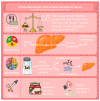Ultra-Processed Food Intake Is Associated with Non-Alcoholic Fatty Liver Disease in Adults: A Systematic Review and Meta-Analysis
- PMID: 37242149
- PMCID: PMC10224355
- DOI: 10.3390/nu15102266
Ultra-Processed Food Intake Is Associated with Non-Alcoholic Fatty Liver Disease in Adults: A Systematic Review and Meta-Analysis
Abstract
Non-alcoholic fatty liver disease (NAFLD) is associated with overweight/obesity, metabolic syndrome and type 2 diabetes (T2D) due to chronic caloric excess and physical inactivity. Previous meta-analyses have confirmed associations between ultra-processed food (UPF) intake and obesity and T2D. We aim to ascertain the contribution of UPF consumption to the risk of developing NAFLD. We performed a systematic review and meta-analysis (PROSPERO (CRD42022368763)). All records registered on Ovid Medline and Web of Science were searched from inception until December 2022. Studies that assessed UPF consumption in adults, determined according to the NOVA food classification system, and that reported NAFLD determined by surrogate (steatosis) scores, imaging or liver biopsy were included. The association between UPF consumption and NAFLD was assessed using random-effects meta-analysis methods. Study quality was assessed, and evidence credibility evaluated, using the Newcastle Ottawa Scale and NutriGrade systems, respectively. A total of 5454 records were screened, and 112 records underwent full text review. From these, 9 studies (3 cross-sectional, 3 case-control and 3 cohort), analysing 60,961 individuals, were included in the current review. Both moderate (vs. low) (pooled relative risk 1.03 (1.00-1.07) (p = 0.04) (I2 = 0%)) and high (vs. low) (1.42 (1.16-1.75) (<0.01) (I2 = 89%)) intake of UPF significantly increased the risk of NAFLD. Funnel plots demonstrate low risk of publication bias. Consumption of UPF is associated with NAFLD with a dose-response effect. Public health measures to reduce overconsumption of UPF are imperative to reduce the burden of NAFLD, and the related conditions, obesity and T2D.
Keywords: NOVA; non-alcoholic fatty liver disease; non-alcoholic steatohepatitis; ultra-processed food.
Conflict of interest statement
The authors declare no conflict of interest.
Figures








References
-
- Chalasani N., Younossi Z., Lavine J.E., Diehl A.M., Brunt E.M., Cusi K., Charlton M., Sanyal A.J. The diagnosis and management of non-alcoholic fatty liver disease: Practice Guideline by the American Association for the Study of Liver Diseases, American College of Gastroenterology, and the American Gastroenterological Association. Hepatology. 2012;55:2005–2023. doi: 10.1002/hep.25762. - DOI - PubMed
-
- Lu F.B., Hu E.D., Xu L.M., Chen L., Wu J.L., Li H., Chen D.Z., Chen Y.P. The relationship between obesity and the severity of non-alcoholic fatty liver disease: Systematic review and meta-analysis. Expert. Rev. Gastroenterol. Hepatol. 2018;12:491–502. doi: 10.1080/17474124.2018.1460202. - DOI - PubMed
-
- Cuthbertson D.J., Koskinen J., Brown E., Magnussen C.G., Hutri-Kähönen N., Sabin M., Tossavainen P., Jokinen E., Laitinen T., Viikari J., et al. Fatty liver index predicts incident risk of prediabetes, type 2 diabetes and non-alcoholic fatty liver disease (NAFLD) Ann. Med. 2021;53:1256–1264. doi: 10.1080/07853890.2021.1956685. - DOI - PMC - PubMed
-
- Sattar N., McConnachie A., Ford I., Gaw A., Cleland S.J., Forouhi N.G., McFarlane P., Shepherd J., Cobbe S., Packard C. Serial metabolic measurements and conversion to type 2 diabetes in the west of Scotland coronary prevention study: Specific elevations in alanine aminotransferase and triglycerides suggest hepatic fat accumulation as a potential contributing factor. Diabetes. 2007;56:984–991. doi: 10.2337/db06-1256. - DOI - PubMed
Publication types
MeSH terms
LinkOut - more resources
Full Text Sources
Medical

